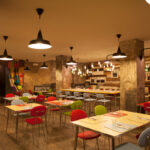
The Chaise Longue: Elegance and Comfort in Modern Design
May 7, 2024
Beyond Taste: A Practical Guide to Furnishing Bars and Restaurants
June 13, 2024Sustainable Mobility in Cities: The Key Role of Urban Furniture






Modern cities are undergoing a transformation driven by the adoption of sustainable practices and the increased use of bicycles as a daily mode of transportation. In this evolving urban landscape, the importance of well-designed infrastructure for bicycle parking is paramount. These spaces not only enhance urban livability but also play a crucial role in attracting and supporting tourism.
The presence of secure and accessible bike racks encourages city dwellers to opt for bicycles more frequently, thus reducing vehicular traffic and air pollution. This not only makes cities quieter and cleaner but also promotes an active and healthy lifestyle among residents. Well-planned cycling infrastructure, including bike racks, is essential for an effective and integrated mobility network.
Bicycle infrastructure is also vital for tourism. Tourists often seek convenient and sustainable ways to explore a city, and cycling offers a unique opportunity to experience the urban environment from a more intimate and engaging perspective. Adequate bike racks ensure that visitors can easily find safe places to leave their bicycles while exploring attractions, restaurants, and shops.
One of the most notable examples of bike racks that combine aesthetics and functionality is the Dolmen. This bike rack, capable of accommodating up to 10 bicycles, is made of galvanized and painted steel. This ensures durability and a peculiar resistance to weather elements. The structure of the Dolmen also allows for easy cleaning underneath the rack, providing a cleaner and well-maintained parking area by preventing the accumulation of leaves and wind-blown debris. The design, inspired by Olympic rings, is not only visually appealing but also highly functional, adapting to a variety of bicycle types, including electric and mountain bikes. With its compact footprint, the Dolmen is an ideal solution for dense urban spaces where efficient use of space is crucial.
Implementing modern and functional bike racks like the Dolmen is a winning strategy for cities aiming to become greener, more efficient, and more welcoming to both residents and visitors. Investing in this infrastructure is not just an improvement in urban quality of life, but also a step forward towards the goal of sustainable and future-oriented cities.